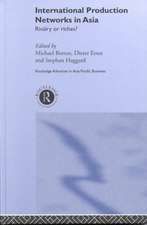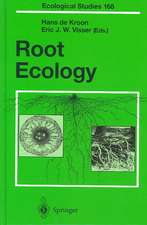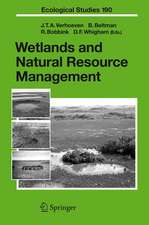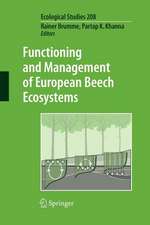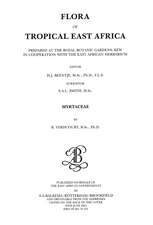Growth and Defence in Plants: Resource Allocation at Multiple Scales: Ecological Studies, cartea 220
Editat de R. Matyssek, Hans Schnyder, Wolfgang Oßwald, Dieter Ernst, Jean Charles Munch, Hans Pretzschen Limba Engleză Paperback – 15 oct 2014
| Toate formatele și edițiile | Preț | Express |
|---|---|---|
| Paperback (1) | 1226.42 lei 6-8 săpt. | |
| Springer Berlin, Heidelberg – 15 oct 2014 | 1226.42 lei 6-8 săpt. | |
| Hardback (1) | 1229.10 lei 6-8 săpt. | |
| Springer Berlin, Heidelberg – 15 sep 2012 | 1229.10 lei 6-8 săpt. |
Din seria Ecological Studies
- 18%
 Preț: 1118.93 lei
Preț: 1118.93 lei -
 Preț: 553.71 lei
Preț: 553.71 lei - 18%
 Preț: 1680.55 lei
Preț: 1680.55 lei - 18%
 Preț: 1003.38 lei
Preț: 1003.38 lei - 20%
 Preț: 1004.69 lei
Preț: 1004.69 lei -
 Preț: 480.62 lei
Preț: 480.62 lei - 5%
 Preț: 752.26 lei
Preț: 752.26 lei - 15%
 Preț: 643.99 lei
Preț: 643.99 lei - 15%
 Preț: 644.18 lei
Preț: 644.18 lei - 15%
 Preț: 652.49 lei
Preț: 652.49 lei - 18%
 Preț: 789.83 lei
Preț: 789.83 lei -
 Preț: 382.36 lei
Preț: 382.36 lei - 15%
 Preț: 643.48 lei
Preț: 643.48 lei - 15%
 Preț: 646.30 lei
Preț: 646.30 lei - 15%
 Preț: 634.32 lei
Preț: 634.32 lei -
 Preț: 384.86 lei
Preț: 384.86 lei - 18%
 Preț: 789.98 lei
Preț: 789.98 lei - 15%
 Preț: 645.14 lei
Preț: 645.14 lei - 15%
 Preț: 649.39 lei
Preț: 649.39 lei - 18%
 Preț: 1005.43 lei
Preț: 1005.43 lei - 18%
 Preț: 949.23 lei
Preț: 949.23 lei - 15%
 Preț: 649.54 lei
Preț: 649.54 lei - 15%
 Preț: 643.34 lei
Preț: 643.34 lei - 15%
 Preț: 649.71 lei
Preț: 649.71 lei - 15%
 Preț: 638.76 lei
Preț: 638.76 lei - 18%
 Preț: 957.62 lei
Preț: 957.62 lei - 18%
 Preț: 1235.25 lei
Preț: 1235.25 lei - 18%
 Preț: 962.18 lei
Preț: 962.18 lei - 18%
 Preț: 949.23 lei
Preț: 949.23 lei - 15%
 Preț: 660.68 lei
Preț: 660.68 lei -
 Preț: 397.76 lei
Preț: 397.76 lei - 15%
 Preț: 638.24 lei
Preț: 638.24 lei - 18%
 Preț: 942.31 lei
Preț: 942.31 lei - 18%
 Preț: 1232.57 lei
Preț: 1232.57 lei - 15%
 Preț: 651.34 lei
Preț: 651.34 lei - 18%
 Preț: 952.72 lei
Preț: 952.72 lei - 18%
 Preț: 1834.27 lei
Preț: 1834.27 lei - 18%
 Preț: 1229.10 lei
Preț: 1229.10 lei -
 Preț: 423.95 lei
Preț: 423.95 lei - 18%
 Preț: 948.92 lei
Preț: 948.92 lei
Preț: 1226.42 lei
Preț vechi: 1495.63 lei
-18% Nou
Puncte Express: 1840
Preț estimativ în valută:
234.68€ • 245.64$ • 195.32£
234.68€ • 245.64$ • 195.32£
Carte tipărită la comandă
Livrare economică 31 martie-14 aprilie
Preluare comenzi: 021 569.72.76
Specificații
ISBN-13: 9783642428784
ISBN-10: 3642428789
Pagini: 500
Ilustrații: XXVI, 474 p.
Dimensiuni: 155 x 235 x 26 mm
Greutate: 0.69 kg
Ediția:2012
Editura: Springer Berlin, Heidelberg
Colecția Springer
Seria Ecological Studies
Locul publicării:Berlin, Heidelberg, Germany
ISBN-10: 3642428789
Pagini: 500
Ilustrații: XXVI, 474 p.
Dimensiuni: 155 x 235 x 26 mm
Greutate: 0.69 kg
Ediția:2012
Editura: Springer Berlin, Heidelberg
Colecția Springer
Seria Ecological Studies
Locul publicării:Berlin, Heidelberg, Germany
Public țintă
ResearchCuprins
The balance between resource sequestration and retention – a challenge in plant science.- Common links of molecular biology with biochemistry and physiology in plants under ozone and pathogen attack.- Host-parasite interactions and trade-offs between growth and defence related metabolism under changing environments.- Conifer Defense Against Insects and Fungal Pathogens.- The rhizosphere: molecular interactions between microorganisms and roots.- Stores as substrate sources of respiration – effects of nitrogen stress and day length.- Tracing carbon fluxes – resolving complexity using isotopes.- Solar radiation as a driver for growth and competition in forest stands.- Site conditions and tree-internal nutrient partitioning in mature European beech and Norway spruce at the Kranzberger Forst.- Plants and their ectomycorrhizosphere – cost and benefit of symbiotic soil organisms.- Case study „Kranzberger Forst“ – growth and defence in European beech (Fagus sylvatica L.) and Norway spruce (Picea abies (L.) Karst.).- Growth and space use in competitive interactions between juvenile trees.- Allometry of tree crown structure. Relevance for space occupation at the individual plant level and for self-thinning at the stand level.- Principles of growth partitioning between trees in forest stands under stress.- Mechanistic modelling of soil-plant-atmosphere systems.- Learning from various plants and scenarios – statistical modeling.- Modeling the defensive potential of plants.- Effects of stress and defence allocation on tree growth - simulation results at the individual and stand level.- Predictability of plant resource allocation – new theory needed?- Conclusions and Perspectives.
Textul de pe ultima copertă
Plants use resources, i.e. carbon, nutrients, water and energy, either for growth or to defend themselves from biotic and abiotic stresses. This volume provides a timely understanding of resource allocation and its regulation in plants, linking the molecular with biochemical and physiological-level processes. Ecological scenarios covered include competitors, pathogens, herbivores, mycorrhizae, soil microorganisms, carbon dioxide/ozone regimes, nitrogen and light availabilities. The validity of the “Growth-Differentiation Balance Hypothesis” is examined and novel theoretical concepts and approaches to modelling plant resource allocation are discussed. The results presented can be applied in plant breeding and engineering, as well as in resource-efficient stand management in agriculture and forestry.
Caracteristici
Written by experts Richly illustrated An invaluable source of information for plant scientists, ecologists, ecophysiologists, plant pathologists, molecular biologists, agronomists, forest scientists, plant breeders, modelers, and advanced students Includes supplementary material: sn.pub/extras Includes supplementary material: sn.pub/extras

